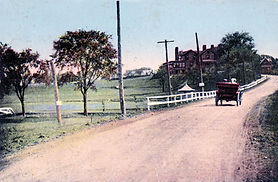Seneca Turnpike
One of the fundamental rules of those closing years of the eighteenth century and the beginning years of the nineteenth century was dictated by the need of the workers to live near their work. Transportation was limited to the use of horses, it was an absolute necessity that homes be located near mills. Since the mills had to be located at the best power sites in order to use the weight of falling water to turn the wheels of industry, it followed that the homes had to be near the work.
As business boomed, so grew the hamlets and villages that were dependent on the power of the creeks. However, there is a village halfway between New Hartford and Kirkland that was not located on a major creek. This is Middlesettlement, farming country, that had another important business. The building of the Seneca Turnpike through the little village and into New Hartford, and on into Utica. Built about 1800, it was the only east-to-west road and it brought many travelers into the area, thereby causing the need for large and friendly taverns and inns of which there were a number in Middlesettlement. In that day roads were toll roads, and were not built by state or local funds, but were constructed by a company of local stockholders. Sanger, a man of much activity and wealth, was a stockholder, and through his influence, the turnpike was brought directly into New Hartford. At that time, New Hartford was a larger and more important town than Utica. Its businesses and inns were larger and its Congregational Church (now the Presbyterian Church) was centrally located and afforded a suitable meeting place for many purposes. The Seneca Turnpike became the responsibility of the state in 1852 as the turnpike companies dissolved due to lack of profits.
The Seneca Turnpike became part of the greater highway stretching from Albany to Buffalo. The stories of the old road are now largely gone, and the name is forgotten. So too are the old toll gates and the keepers' houses and many of the fine inns. Yet at one time it was the state's leading highway. The Seneca Turnpike remained a well-traveled route to Syracuse and points west until the construction of the interstate highway system in the 1950s.
Today, this roadway still carries a large share of traffic that winds through the village of New Hartford and the surrounding area.

Also known as the Genesee Road, and still called Genesee Street in many towns. This photo shows the road in 1913 as it passes through rural New Hartford.

The Seneca Turnpike was home to many family farms, such as the Wester Farm near the Woods Road turnoff. Purchased in 1906, the farm had a 21 room house, dairy barns, a creamery, ice house and sold their products as the Seneca Dairy.

Palmer's Inn was built on the east-west path traveled by Native Americans. This path was the beginning of the Seneca Turnpike.
